Investigation of 3.3 kV 4H-SiC DC-FSJ MOSFET Structures
Abstract
:1. Introduction
2. Structures of MOSFETs
3. Influence of Structure and Doping
3.1. Floating P-Type Structure Depth
3.2. Concentration of N1 Epitaxial Layer
3.3. Thickness of N1 Epitaxial Layer
3.4. Floating P-Type Structures in the Different Epitaxial Layers in the Drift Region
4. Comparison of Electrical Properties
5. Conclusions
Author Contributions
Funding
Acknowledgments
Conflicts of Interest
References
- Baliga, B.J. Fundamentals of Power Semiconductor Devices; Springer: New York, NY, USA, 2008. [Google Scholar]
- Godignon, P.; Soler, V.; Cabello, M.; Montserrat, J.; Rebollo, J.; Knoll, L.; Bianda, E.; Mihaila, A. New Trends in High Voltage MOSFET Based on Wide Band Gap Materials. In Proceedings of the International Semiconductor Conference (CAS), Sinaia, Romania, 11–14 October 2017. [Google Scholar]
- Millanv, J. A Survey of Wide Bandgap Power Semiconductor Devices. IEEE Trans. Power Electron. 2013, 29, 2155–2163. [Google Scholar] [CrossRef]
- Marckx, D.A. Breakthrough in Power Electronics from SiC; NREL/SR-500-38515; Nat. Renewable Energy Lab.: Golden, CO, USA, 2006. [Google Scholar]
- León-Masich, A.; Valderrama-Blavi, H.; Bosque-Moncusí, J.M.; Martínez-Salamero, L. Efficiency comparison between Si and SiC-based implementations in a high gain DC-DC boost converter. IET Power Electron. 2015, 8, 869–878. [Google Scholar] [CrossRef]
- Masuda, T.; Kosugi, R.; Hiyoshi, T. 0.97 mΩcm2/820 V 4H-SiC super junction V-groove trench MOSFET. In Proceedings of the European Conference on Silicon Carbide and Related Materials (ECSCRM), Thessaloniki, Greece, 10–14 May 2017; pp. 483–488. [Google Scholar]
- Ueda, D.; Takagi, H.; Kano, G. A new vertical power MOSFET structure with extremely reduced on-resistance. IEEE Trans Electron Devices 1985, 32, 2–6. [Google Scholar] [CrossRef]
- Palmour, J.W.; Cheng, L.; Pala, V.; Brunt, E.V.; Lichtenwalner, D.J.; Wang, G.-Y.; Richmond, J.; O’Loughlin, M.; Ryu, S.; Allen, S.T.; et al. Silicon Carbide Power MOSFETs: Breakthrough Performance from 900 V up to 15 kV. In Proceedings of the 26th International Symposium on Power Semiconductor Devices & IC’s, Waikoloa, HI, USA, 15–19 June 2014. [Google Scholar]
- Matin, M.; Saha, A.; Cooper, J.A. A Selfn-Aligned Process for High-Voltage, Short-Channel Vertical DMOSFETs in 4H-SiC. IEEE Trans. Electron Devices 2004, 51, 1721–1725. [Google Scholar] [CrossRef]
- Wang, S.R.; Cooper, J.A. Double-Self-Aligned Power DMOSFETs in 4H-SiC. In Proceedings of the Device Research Conference, University Park, PA, USA, 22–24 June 2009; pp. 277–278. [Google Scholar]
- Cheng, L.; Ryu, S.H.; Jonas, C.; Dhar, S.; Callanan, R.; Richmond, J.; Agarwal, A.K.; Palmour, J. 3300V, 30A 4H-SiC Power DMOSFETs. In Proceedings of the International Semiconductor Device Research Symposium, College Park, MD, USA, 9–11 December 2009; pp. 1–2. [Google Scholar]
- Bolotnikov, A.; Losee, P.; Matocha, K.; Glaser, J.; Nasadoski, J.; Wang, L.; Elasser, A.; Arthur, S.; Stum, Z.; Sandvik, P.; et al. 3.3 kV SiC MOSFETs Designed for Low On-Resistance and Fast Switching. In Proceedings of the ISPSD 2012, Bruges, Belgium, 3–7 June 2012; pp. 389–392. [Google Scholar]
- Huang, X.; Vursin, L.; Bhalla, A.; Simon, W.; Dries, J.C. Design and fabrication of 3.3 KV SiC MOSFETs for industrial applications. In Proceedings of the ISPSD 2017, Sapporo, Japan, 28 May–1 June 2017; pp. 255–258. [Google Scholar]
- Saha, A.; Cooper, J.A. A 1-kV 4H-SiC power DMOSFET optimized for low on-resistance. IEEE Trans. Electron. Devices 2007, 54, 2786–2791. [Google Scholar] [CrossRef]
- Zhou, X.; Yue, R.; Dai, G.; Li, J.; Wang, Y. An improved structure to enhance the robustness of SiC power MOSFETs for a low Ron, sp. In Proceedings of the IEEE International Conference on Electron Devices and Solid-State Circuits (EDSSC), Hong Kong, China, 3–5 August 2016. [Google Scholar]
- Shi, S.; Zhou, X.; Yue, R.; Wang, Y. An improved structure of 3.3kV 4H-SiC VDMOSFETs with lower on-resistance and reverse transfer capacitance. In Proceedings of the 13th IEEE International Conference on Solid-State and Integrated Circuit Technology (ICSICT), Hangzhou, China, 25–28 October 2016. [Google Scholar]
- Liu, T.; Hu, S.; Wang, J.; Guo, G.; Luo, J.; Wang, Y.; Guo, J.; Huo, Y. An Investigation of Electric Field and Breakdown Voltage Models for a Deep Trench Superjunction SiC VDMOS. IEEE Access 2019, 7, 145118–145123. [Google Scholar] [CrossRef]
- Qian, Q.; Sun, W.; Zhu, J.; Liu, S. A novel charge-imbalance termination for trench superjunction VDMOS. IEEE Electron Device Lett. 2010, 31, 1434–1436. [Google Scholar] [CrossRef]
- Hu, S.; Huang, Y.; Liu, T.; Guo, J.; Wang, J.; Luo, J. A comparative study of a deep-trench superjunction SiC VDMOS device. Comput. J. Electron. 2019, 18, 553–560. [Google Scholar] [CrossRef]
- Qingwen, S.; Xiaoyan, T.; Yimeng, Z.; Yuming, Z.; Yimen, Z. Investigation of SiC trench MOSFET with floating islands. IET Power Electron. 2016, 9, 2492–2499. [Google Scholar] [CrossRef]
- Vaid, R.; Padha, N. A novel trench gate floating islands power MOSFET (TG-FLIMOSFET): Two-dimensional simulation study. Microelectron. Eng. 2011, 88, 3316–3326. [Google Scholar] [CrossRef]
- Baliga, B.J. Advanced Power MOSFET Concepts; Springer: New York, NY, USA, 2010. [Google Scholar]
- Scognamillo, C.; Catalano, A.P.; Lasserre, P.; Duchesne, C.; d’Alessandro, V.; Castellazzi, A. Combined experimental-FEM investigation of electrical ruggedness in double-sided cooled power modules. Microelectron. Reliab. 2020, 114, 113742. [Google Scholar] [CrossRef]


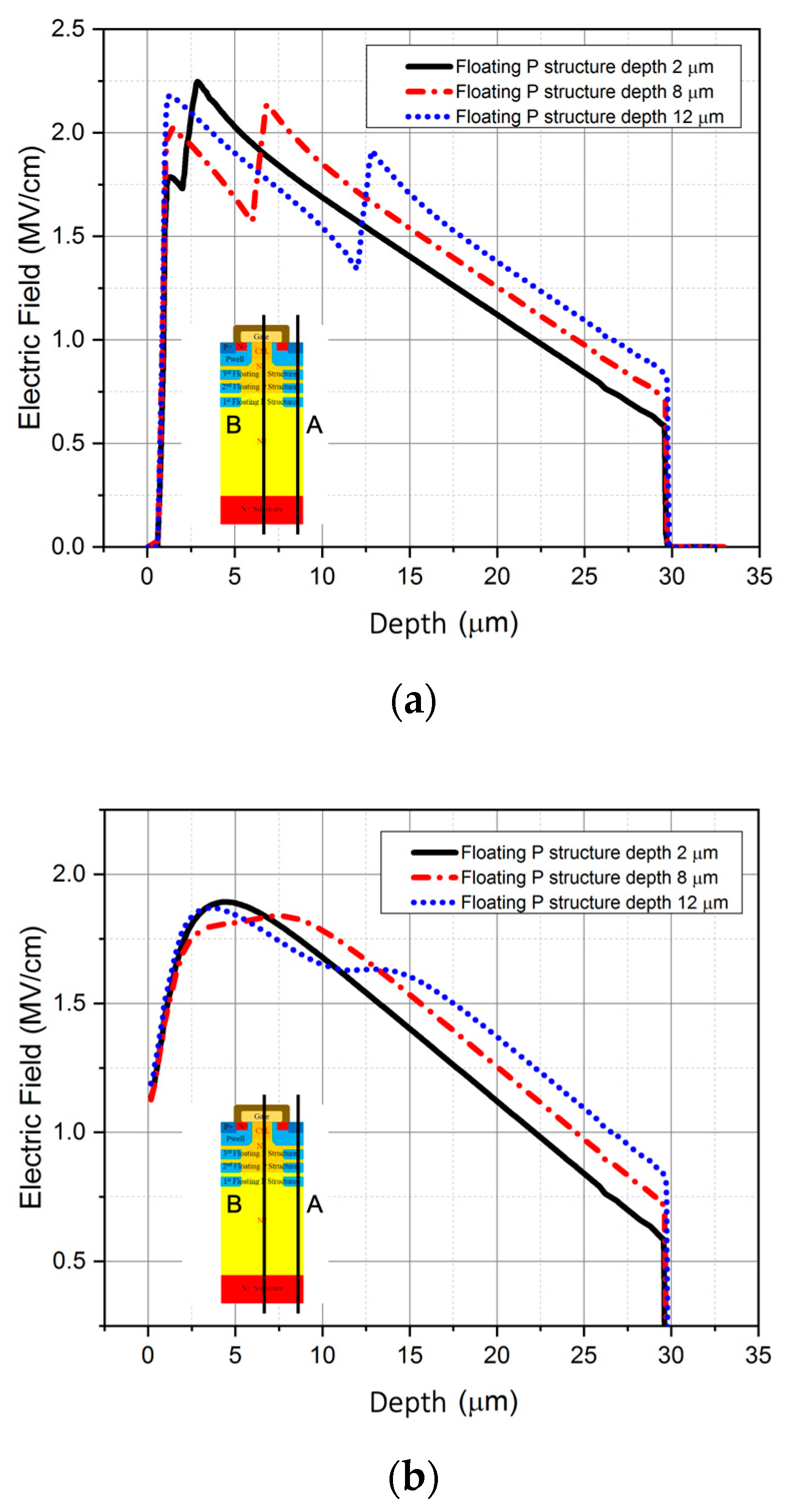
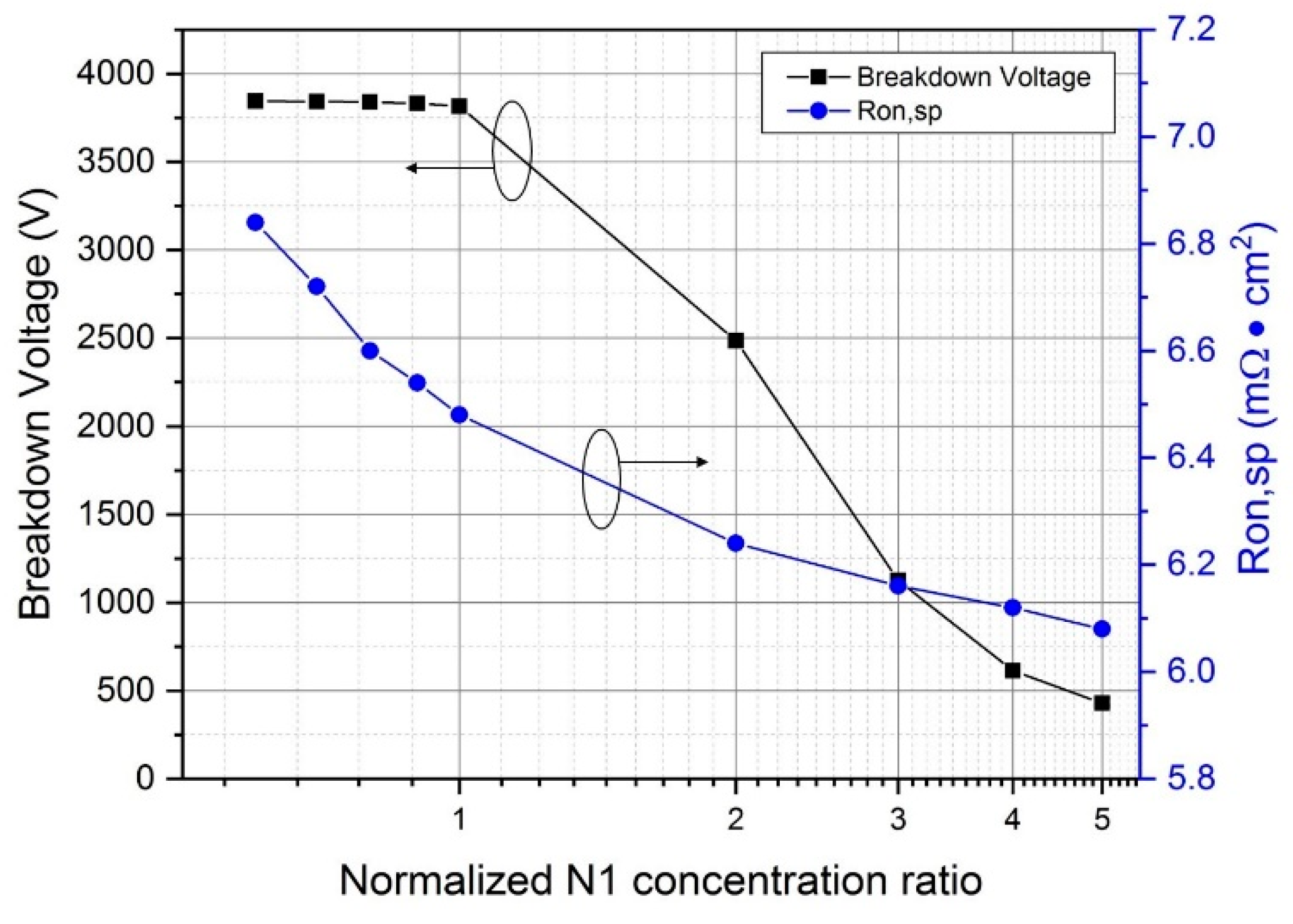
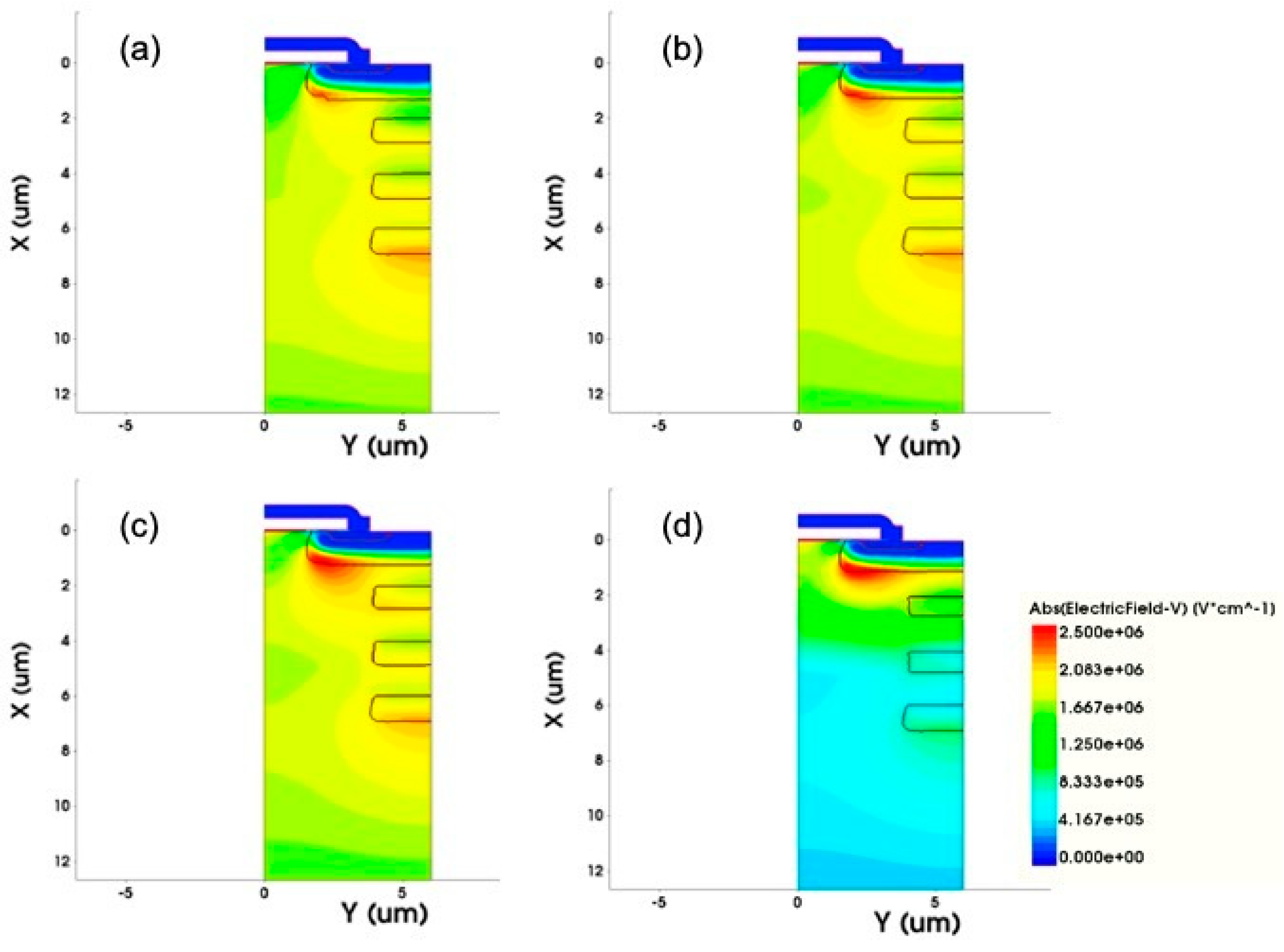


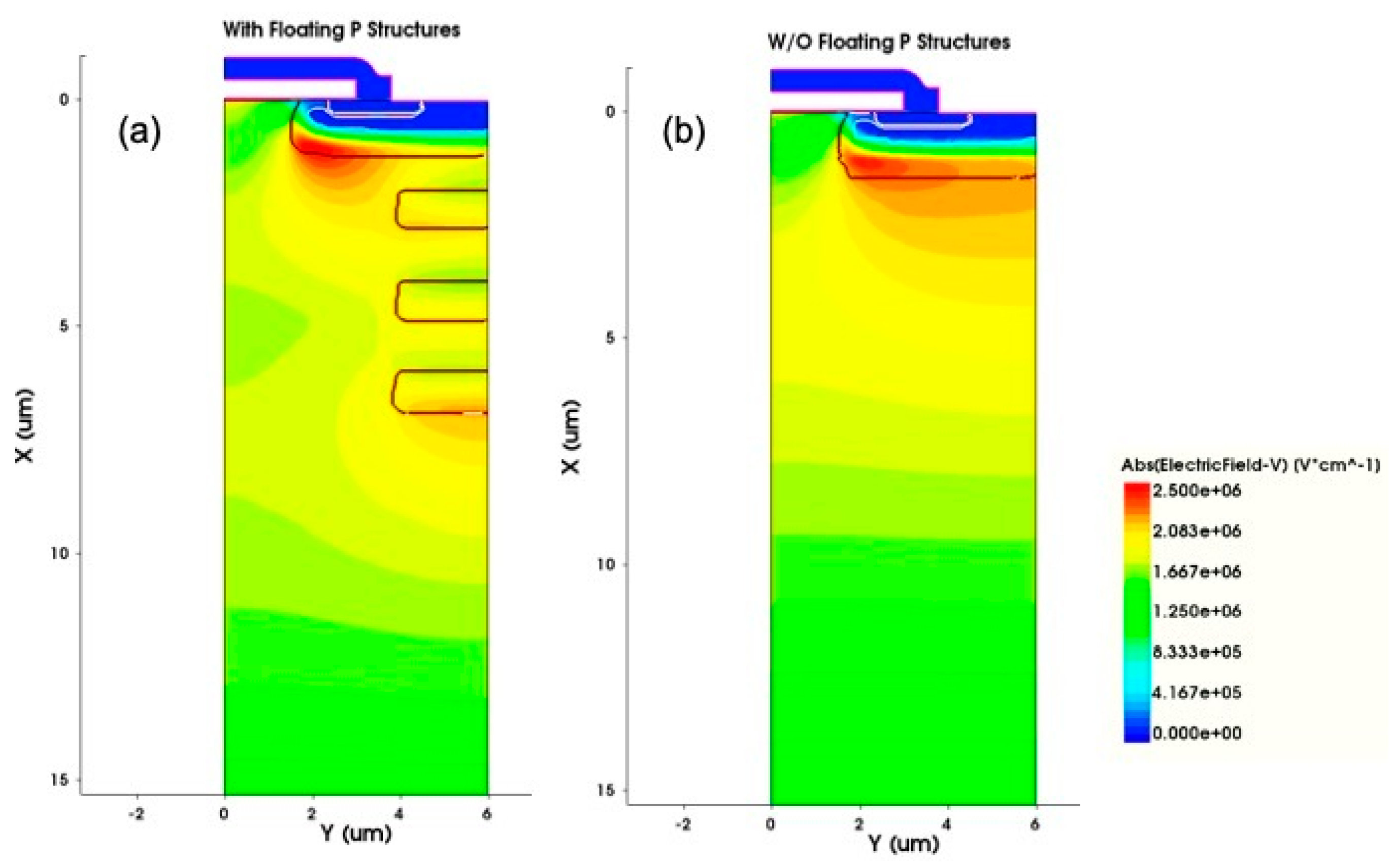
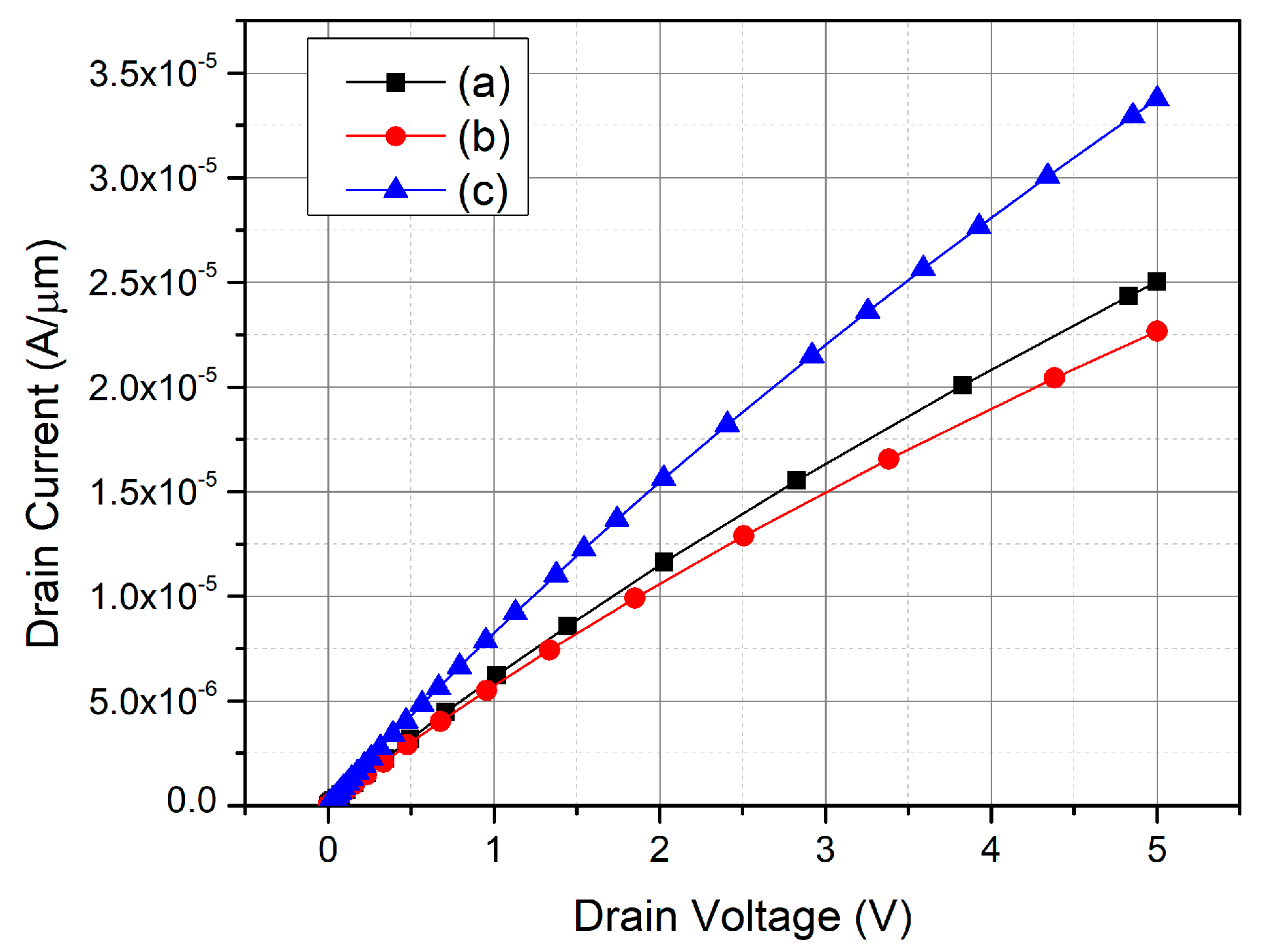
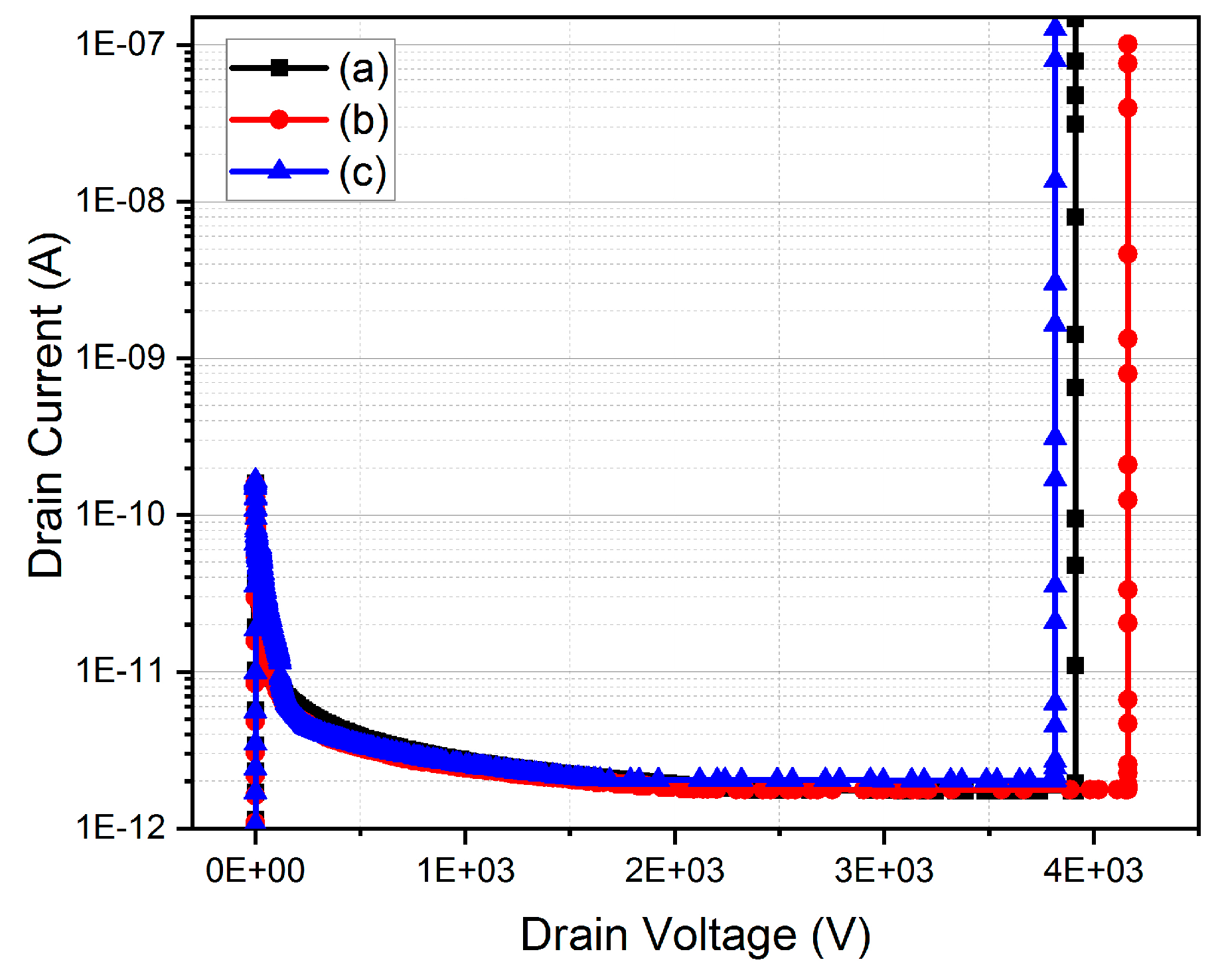
| Parameter | Traditional | FSJ | DC-FSJ |
|---|---|---|---|
| Thickness (μm) | 30 | 30 | 26 |
| Ron,sp(mΩ·cm2) | 8.66 | 9.12 | 6.5 |
| BV (V) | 3912 | 4162 | 3815 |
| Vth (V) | 3.13 | 3.35 | 3.29 |
| BFOM (MW/cm2) | 1767 | 1899 | 2239 |
Publisher’s Note: MDPI stays neutral with regard to jurisdictional claims in published maps and institutional affiliations. |
© 2021 by the authors. Licensee MDPI, Basel, Switzerland. This article is an open access article distributed under the terms and conditions of the Creative Commons Attribution (CC BY) license (https://creativecommons.org/licenses/by/4.0/).
Share and Cite
Chen, C.-Y.; Lai, Y.-K.; Lee, K.-Y.; Huang, C.-F.; Huang, S.-Y. Investigation of 3.3 kV 4H-SiC DC-FSJ MOSFET Structures. Micromachines 2021, 12, 756. https://doi.org/10.3390/mi12070756
Chen C-Y, Lai Y-K, Lee K-Y, Huang C-F, Huang S-Y. Investigation of 3.3 kV 4H-SiC DC-FSJ MOSFET Structures. Micromachines. 2021; 12(7):756. https://doi.org/10.3390/mi12070756
Chicago/Turabian StyleChen, Chia-Yuan, Yun-Kai Lai, Kung-Yen Lee, Chih-Fang Huang, and Shin-Yi Huang. 2021. "Investigation of 3.3 kV 4H-SiC DC-FSJ MOSFET Structures" Micromachines 12, no. 7: 756. https://doi.org/10.3390/mi12070756





